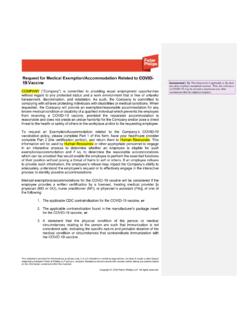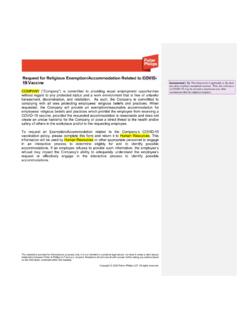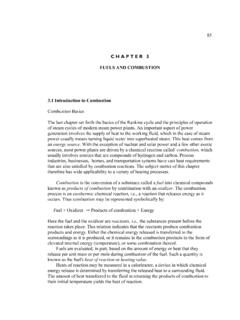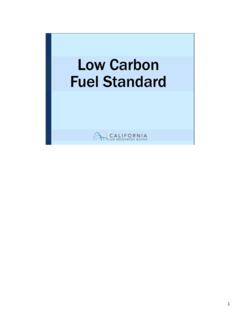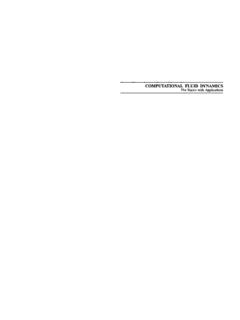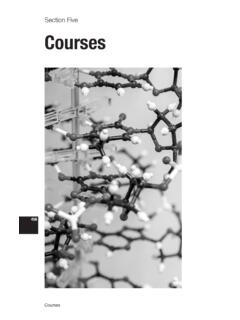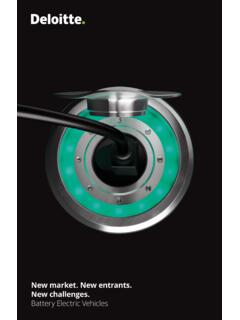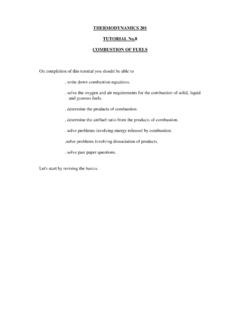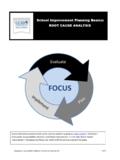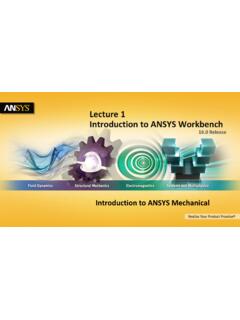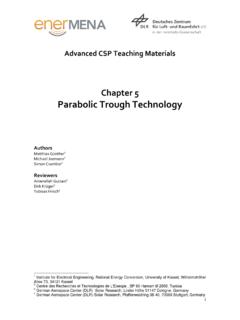Transcription of Combustible Dust Hazard Analysis and NFPA Standards
1 Copyright 2016 All Rights Reserved1 Combustible Dust Hazard Analysis and NFPA StandardsPresented by:Brian Edwards (CTI)Moderated by:Howard Mavity (Fisher Phillips) Copyright 2016 All Rights Reserved2 Reasons that Employers Are Still Caught Unaware. Employers do not realize that they have Combustible dust issues. Past guidance, including from OEMs, may be wrong or circumstances may have changed reliance on others is not a defense. Fire departments and state and local regulators may not be educated on Combustible dust hazards. Combustible dust may accumulate over many years before it becomes a potential explosion problem or an incident occurs. The five necessary elements of a dust explosion may not have been present before recent changes. Contractors and maintenance departments may not have considered the effects of one change on Combustible dust issues - no management of change process.
2 Manufacturers/Contractors may not have adhered to NFPA Standards at the Copyright 2016 All Rights Reserved3 Employers May be Vulnerable and then Respond Incorrectly. There is confusion about the roles of NFPA Standards and about NFPA 652. The first step of a Process or Dust Hazard Analysis is often underutilized or badly done. Focused on by new NFPA 652. If you don t conduct a Dust Analysis to justify your actions, OSHA will use a Checklist-approach and shape the discussion. There are many approaches to Abatement/Compliance. Compliance takes longer than expected and presents interim legal exposure. Employers overlook Repeat and Willful OSHA exposure. Experts and Counsel have important Copyright 2016 All Rights Reserved4 Examples of Applicable OSHA StandardsOSHA Directive CPL-03-008-006 (Effective 3/11/08) Still the guide for OSHA inspections.
3 (a) PPE/protective clothing in flash fire areas confined spaces , where dust is a highly hazardous chemical Means of egress Emergency Action Plans (EAP) Fire Brigades Portable fire Extinguishers Copyright 2016 All Rights Reserved5 OSHA Cites Most Combustible Dust Hazards Under It s General Duty Clause ApproachIn the absence of specific Standards , OSHA relies on Section 5(a)(1) of the OSHAct: Each furnish to each of his employees employment and a place of employment which are free from recognized hazards that are causing or are likely to cause death or serious harm to his employees. OSHA must prove: that a serious Hazard is recognized by the employer's industry or the employer; and there is a feasible and useful method for abating the shows Recognition? Does the industry recognize the Hazard and by extension, the responses/abatements?
4 Consensus Standards are not automatically accepted as recognized by the industry. OSHA cites for hazards, not specific abatements. Employers may also follow consensus Standards as best practices but argue that all or parts of Standards are not legally Copyright 2016 All Rights Reserved6 Examples of Common OSHA Citations. Dust collectors or air material separators were located inside building without proper explosion protection. Air from dust collectors was recycled back into building. Lack of explosion isolation between equipment. Lack of bonding or grounding of equipment. Duct work from the dust collection system to other areas of the plant were not constructed of metal. Housekeeping, dust accumulation, and cleaning methods. Lack of Employee Training. Need for classified electrical system and powered industrial Copyright 2016 All Rights Reserved7 Fisher & Phillips LLP is dedicated exclusively torepresenting employers in the practice ofemployment, labor, benefits, OSHA, and immigration law and related MATERIALS AND THE INFORMATION PROVIDED DURING THE PROGRAM SHOULD NOT BE CONSTRUED AS LEGAL ADVICE OR AS CRITICAL OF THE CURRENT OR PAST CTI and the PresenterConversion Technology, Inc.
5 (CTI) is an Environmental and Safety Engineering Firm with over 30 years experience working with industrial clients across North Edwards, PEDirector of EngineeringPrincipal Member of NFPA 61 Conversion Technology @ctiengineersIntroduction Combustible dust is a major Hazard in the solids handling industries. Today we will discuss:- basics of Combustible Dust- NFPA Standards - Conducting a Dust Hazard AnalysisImage from Chemical Safety BoardWhat do we mean when we talk about Combustible dust? Combustible Dust is a particulate solid that presents a fire Hazard when suspended in air .. regardless of size or shape. - NFPA Layman s terms: if it can burn, and it hangs in air (even briefly), it is likely a Combustible dust. Combustible Dust can be: dry food, plastics, wood, rubber, textiles, pesticides, pharmaceuticals, dyes, coal, and metals, among many other in Particle Size The rate of combustion of a material depends on particle size, and smaller particles have increased burning rates.
6 Normally slow burning material can create flash fires if particles are sufficiently small and suspended in Hazards of Combustible Dust FIRE: The rapid oxidation of a material in the chemical process of combustion , releasing heat, light, and various reaction products. DEFLAGRATION: Propagation of a combustion zone at a velocity that is less than the speed of sound in the un-reacted medium. (From NFPA 654) EXPLOSION: An explosion is a rapid increase in volume and release of energy in an extreme manner, usually with the generation of high temperatures and the release of gases. Image from US Chemical Safety BoardFire TriangleDeflagrations For a free-air deflagration to occur, four conditions must be met: Having all four conditions come together simultaneously is relatively rare in most facilities. However, if rooms or pieces of equipment have the potential for dust concentrations to reach the MEC, then a deflagration Hazard exists.
7 Small Combustible particles are present (fuel) The particles are suspended in the air in sufficient quantity Available oxygen Ignition source (energy)Suspension of a Dust CloudFor a deflagration to occur, the dust cloud must be suspended in a sufficient density the Minimum Explosion Concentration (MEC).Insufficient ConcentrationSufficient ConcentrationDeflagrations Deflagrations release energy in the form of heat very rapidly. This heat increases the air temperature and causes the air and combustion gases to rapidly expand. As this expansion occurs, local pressure gradients develop. The pressure gradient ( pressure wave) propagates with the Explosions Explosion hazards exist when all four conditions needed for a deflagration can occur within an enclosure whether it is a room, building, container, or piece of equipment. Most dust explosions originate inside pieces of equipment or containers.
8 Fires and Explosions often occur in the following types of: Dust Collectors (account for over 50% of incidents) Silos / Bins Dryers / Ovens Conveyors / ElevatorsExplosion PentagonOxygenContainment of Dust CloudFuelDispersion of Dust CloudIgnition SourceContainment of Dust CloudThe dust cloud must be contained for an explosion to you have a confined dust cloud, all that is missing is an ignition source (assuming oxygen is present).Ignition SourceStart of an ExplosionProcess Equipment ExplosionProcess Equipment ExplosionProcess Equipment ExplosionProcess Equipment ExplosionProcess Equipment ExplosionProcess Equipment ExplosionExplosion Chain Reactions Industrial dust explosions can create a chain-reaction resulting in more explosions and flash fires. Flame fronts can travel through ductwork from equipment to equipment, or pressure waves can disturb settled dust creating a hazardous atmosphere throughout a building.
9 These SECONDARY EXPLOSIONS are often the most PropagationDeflagration PropagationDeflagration PropagationGreatest Hazard of Combustible Dust Dust can accumulate on surfaces, with the smallest particle sizes accumulating in hard to reach places (overhead surfaces), often unnoticed. Primary explosions can dislodge the accumulated dust, and create a much larger, SECONDARY from OSHANFPA Standards for Combustible Dust Several Standards exist to prevent dust fires and explosions. In the USA, the National Fire Protection Association (NFPA) maintains Standards associated with Combustible dust. Several of these Standards were recently updated, or are being updated in NFPA The National Fire Protection Association (NFPA) is charged with creating Standards for fire prevention. NFPA has no enforcement power of their own. Authorities Having Jurisdiction (AHJs) often reference NFPA Standards in their own regulations.
10 Compliance falls on facilities more than equipment manufacturers. Current NFPA Standards The below Standards can apply to Particulate Handling facilities: NFPA 652 Fundamentals of Combustible Dust NFPA 61 Agricultural and Food Processing Facilities NFPA 654 Prevention of Fire and Dust Explosions from Combustible Particulate Solids (General) NFPA 664 Wood Processing and Woodworking Facilities NFPA 68 Standard for Explosion Protection by VentingApplying the Standards NFPA 652 is an overarching standard that applies to all facilities with Combustible dust. NFPA 61, 654, 664 and others are Commodity Specific Standards . Start with 652, and then use the commodity Standards for specific equipment and to be more consistent with industry Standards . When there are differences in 652 and the commodity standard, NFPA allows the user to choose either standard.
